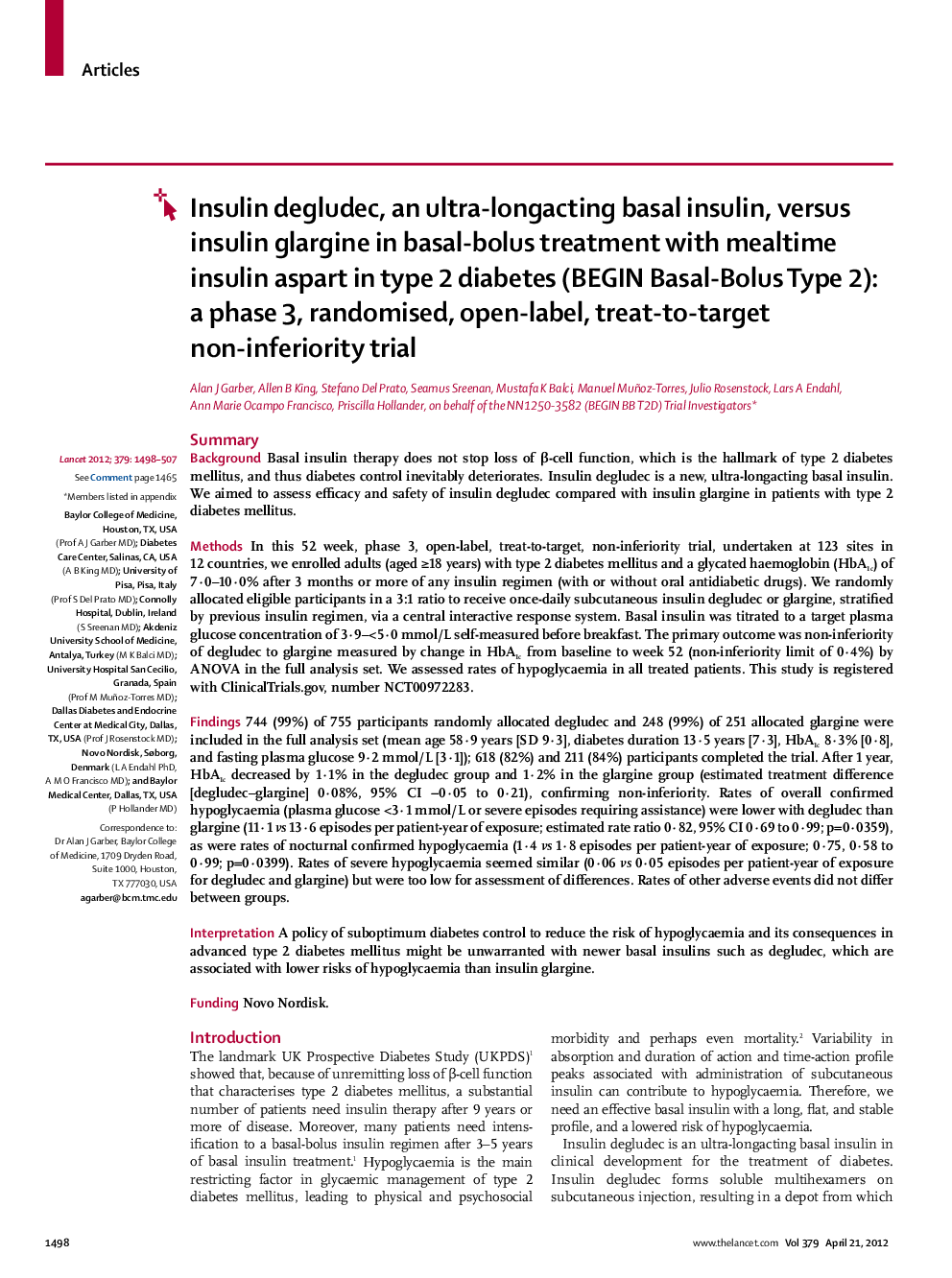| Article ID | Journal | Published Year | Pages | File Type |
|---|---|---|---|---|
| 3492441 | The Lancet | 2012 | 10 Pages |
SummaryBackgroundBasal insulin therapy does not stop loss of β-cell function, which is the hallmark of type 2 diabetes mellitus, and thus diabetes control inevitably deteriorates. Insulin degludec is a new, ultra-longacting basal insulin. We aimed to assess efficacy and safety of insulin degludec compared with insulin glargine in patients with type 2 diabetes mellitus.MethodsIn this 52 week, phase 3, open-label, treat-to-target, non-inferiority trial, undertaken at 123 sites in 12 countries, we enrolled adults (aged ≥18 years) with type 2 diabetes mellitus and a glycated haemoglobin (HbA1c) of 7·0–10·0% after 3 months or more of any insulin regimen (with or without oral antidiabetic drugs). We randomly allocated eligible participants in a 3:1 ratio to receive once-daily subcutaneous insulin degludec or glargine, stratified by previous insulin regimen, via a central interactive response system. Basal insulin was titrated to a target plasma glucose concentration of 3·9–<5·0 mmol/L self-measured before breakfast. The primary outcome was non-inferiority of degludec to glargine measured by change in HbA1c from baseline to week 52 (non-inferiority limit of 0·4%) by ANOVA in the full analysis set. We assessed rates of hypoglycaemia in all treated patients. This study is registered with ClinicalTrials.gov, number NCT00972283.Findings744 (99%) of 755 participants randomly allocated degludec and 248 (99%) of 251 allocated glargine were included in the full analysis set (mean age 58·9 years [SD 9·3], diabetes duration 13·5 years [7·3], HbA1c 8·3% [0·8], and fasting plasma glucose 9·2 mmol/L [3·1]); 618 (82%) and 211 (84%) participants completed the trial. After 1 year, HbA1c decreased by 1·1% in the degludec group and 1·2% in the glargine group (estimated treatment difference [degludec–glargine] 0·08%, 95% CI −0·05 to 0·21), confirming non-inferiority. Rates of overall confirmed hypoglycaemia (plasma glucose <3·1 mmol/L or severe episodes requiring assistance) were lower with degludec than glargine (11·1 vs 13·6 episodes per patient-year of exposure; estimated rate ratio 0·82, 95% CI 0·69 to 0·99; p=0·0359), as were rates of nocturnal confirmed hypoglycaemia (1·4 vs 1·8 episodes per patient-year of exposure; 0·75, 0·58 to 0·99; p=0·0399). Rates of severe hypoglycaemia seemed similar (0·06 vs 0·05 episodes per patient-year of exposure for degludec and glargine) but were too low for assessment of differences. Rates of other adverse events did not differ between groups.InterpretationA policy of suboptimum diabetes control to reduce the risk of hypoglycaemia and its consequences in advanced type 2 diabetes mellitus might be unwarranted with newer basal insulins such as degludec, which are associated with lower risks of hypoglycaemia than insulin glargine.FundingNovo Nordisk.
